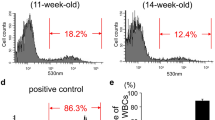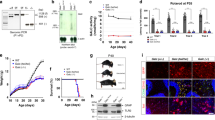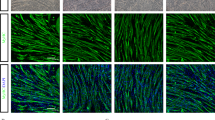Abstract
Twitcher mouse is a murine model of human globoid cell leukodystrophy (Krabbe disease), which is characterized by a genetic deficiency in galactocerebrosidase (GALC) activity. The nervous system is affected early and severely by demyelination in the white matter. So far, there is no effective treatment for Krabbe disease except bone marrow transplantation (BMT). However, BMT has inherent limitations such as unavailability of donors and graft-versus-host disease. In this study, we injected recombinant adenovirus encoding GALC into the lateral ventricle of twitcher mice at postnatal day 0 (PND 0) and the therapeutic effects were evaluated. Our results showed slight, but significant improvements in motor functions, body weight and twitching and a prolonged life span. In brain, GALC activity was increased to 15% that of normal littermates and psychosine concentration was decreased to 55% that of untreated twitcher mice at PND 15. The number of PAS-positive globoid cells in brain stem was also reduced significantly at PND 35. In contrast, when adenoviruses were injected to the twitcher mice at PND 15, almost no improvements were observed. These results demonstrate that the timing of treatment may be of great importance in Krabbe disease.
This is a preview of subscription content, access via your institution
Access options
Subscribe to this journal
Receive 12 print issues and online access
$259.00 per year
only $21.58 per issue
Buy this article
- Purchase on Springer Link
- Instant access to full article PDF
Prices may be subject to local taxes which are calculated during checkout






Similar content being viewed by others
References
Duchen LW et al. Hereditary leucodystrophy in the mouse. The new mutant twitcher Brain 1980 103: 695–710
Kobayashi T et al. The twitcher mouse: an enzymatically authentic model of human globoid cell leukodystrophy (Krabbe disease) Brain Res 1980 202: 479–483
Taniike M, Suzuki K . Spacio-temporal progression of demyelination in twitcher mouse: with clinico-pathological correlation Acta Neuropathol 1994 88: 228–236
Miyatake T, Suzuki K . Globoid cell leukodystrophy: additional deficiency of psychosine galactosidase Biochem Biophys Res Commun 1972 48: 538–543
Igisu T, Suzuki K . Progressive accumulation of toxic metabolite in a genetic leukodystrophy Science 1984 224: 753–755
Kobayashi T et al. Globoid cell leukodystrophy is a generalized galactosylsphingosine(psychosine) storage disease Biochem Biophys Res Commun 1987 144: 41–46
Yeager AM et al. Prolonged survival and remyelination after hematopoietic cell transplantation in the twitcher mouse Science 1984 225: 1052–1054
Suzuki K et al. The twitcher mouse: central nervous system pathology after bone marrow transplantation Lab Invest 1988 58: 302–309
Krivit W et al. Hematopoietic stem-cell transplantation in globoid-cell leukodystrophy N Engl J Med 1998 338: 1119–1126
Chen YQ, Rafi MA, de Gala G, Wenger DA . Cloning and expression of cDNA encoding human galactocerebrosidase, the enzyme deficient in globoid cell leukodystrophy Hum Mol Genet 1993 2: 1841–1845
Sakai N et al. Krabbe disease: isolation and characterization of a full-length cDNA for human galactocerebrosidase Biochem Biophys Res Commun 1994 198: 485–491
Sakai N et al. Molecular cloning and expression of cDNA for murine galactocerebrosidase and mutation analysis of the twitcher mouse, a model of Krabbe's disease J Neurochem 1996 66: 1118–1124
Suzuki K, Suzuki K . The twitcher mouse: a model for Krabbe disease and for experimental therapies Brain Pathol 1995 5: 249–258
Takahashi H, Igisu H, Suzuki K, Suzuki K . The twitcher mouse: an ultrastructural study on the oligodendroglia Acta Neuropathol 1983 59: 159–166
Hannun YA, Bell RM . Lysosphingolipids inhibit protein kinase C: Implications for the sphingolipidoses Science 1987 235: 670–674
Hannun YA, Bell RM . Functions of sphingolipids and sphingolipid breakdown products in cellular regulation Science 1989 243: 500–507
Kornfeld S, Mellman I . The biogenesis of lysosomes Annu Rev Cell Biol 1989 5: 483–525
Rafi MA et al. Retroviral vector-mediated transfer of the galactocerebrosidase (GALC) cDNA leads to overexpression and transfer of GALC activity to neighboring cells Biochem Mol Med 1996 58: 142–150
Daly TM et al. Neonatal gene transfer leads to widespread correction of pathology in a murine model of lysosomal storage disease Proc Natl Acad Sci USA 1999 96: 2296–2300
Niwa H, Yamamura K, Miyazaki J . Efficient selection for high-expression transfectants with a novel eukaryotic vector Gene 1991 108: 193–200
Miyake S et al. Efficient generation of recombinant adenovuruses using adenovirus DNA–terminal protein complex and a cosmid bearing the full-length virus genome Proc Natl Acad Sci USA 1996 93: 1320–1324
Kanegae Y et al. Efficient gene activation in mammalian cells by using recombinant adenovirus expressing site-specific cre recombinase Nucleic Acids Res 1995 23: 3816–3821
Kanegae Y, Makimura M, Saito I . A simple and efficient method for purification of infectious recombinant adenovirus Jpn J Med Sci Biol 1994 47: 157–166
Matsushima GK et al. Absence of MHC class II molecules reduces CNS demyelination, microglial/macrophage infiltration, and twitching in murine globoid cell leukodystrophy Cell 1994 78: 645–656
Raghavan S, Krusell A . Optimal assay conditions for enzymatic characterization of homozygous and heterozygous twitcher mouse Biochim Biophys Acta 1986 877: 1–8
Matsumoto A et al. Transgenic introduction of human galactosylceramidase into twitcher mouse: significant phenotype improvement with a minimal expression Dev Brain Dysfunct 1997 10: 142–154
Lee VML, Page CD, Wu HL, Schlaepfer WW . Monoclonal antibodies to gel-excised glial filament protein and their reactivities with other intermediate filament protein J Neurochem 1984 42: 25–32
Acknowledgements
We would like to thank Dr K Ohno (University of Tottori) for valuable advice on the HPLC method used in the measurement of psychosine and Dr I Saito and Dr Y Kanegae (University of Tokyo) for kindly providing the adenovirus vector. We thank Mr M Aoki (Laboratory Animal Center, The Jikei University School of Medicine) for technical assistance. We also would like to give special thanks to Dr K Suzuki (University of North Carolina) for critical reviewing of this manuscript.
Author information
Authors and Affiliations
Rights and permissions
About this article
Cite this article
Shen, J., Watabe, K., Ohashi, T. et al. Intraventricular administration of recombinant adenovirus to neonatal twitcher mouse leads to clinicopathological improvements. Gene Ther 8, 1081–1087 (2001). https://doi.org/10.1038/sj.gt.3301495
Received:
Accepted:
Published:
Issue Date:
DOI: https://doi.org/10.1038/sj.gt.3301495
Keywords
This article is cited by
-
Brainstem development requires galactosylceramidase and is critical for pathogenesis in a model of Krabbe disease
Nature Communications (2020)
-
HIV Tat Domain Improves Cross-correction of Human Galactocerebrosidase in a Gene- and Flanking Sequence-dependent Manner
Molecular Therapy - Nucleic Acids (2013)
-
Central Nervous System-directed AAV2/5-Mediated Gene Therapy Synergizes with Bone Marrow Transplantation in the Murine Model of Globoid-cell Leukodystrophy
Molecular Therapy (2007)
-
Transgenic rescue of Krabbe disease in the twitcher mouse
Gene Therapy (2004)
-
Brain transplantation of genetically modified bone marrow stromal cells corrects CNS pathology and cognitive function in MPS VII mice
Gene Therapy (2004)



